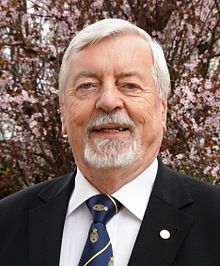Heinrich Hora
Heinrich Hora (* 1. July 1931 in Bodenbach , Czechoslovakia ) is a German - Australian physicists , in particular, handles laser - plasma - interaction is concerned.
Hora went to high school in Aussig and Altenburg and studied physics at the University of Halle-Wittenberg and the University of Jena , where he received his doctorate in theoretical physics in 1959. He then went into industry, working at Carl Zeiss, IBM, Westinghouse (in Pittsburgh) and at Siemens, mainly in the field of solid-state physics and optical detectors (including IBM patent 1964 for diamond deposition from the gas phase). From 1962 he dealt with plasma physics and laser-plasma interaction for fusion at the Max Planck Institute for Plasma Physics in Garching . From 1969 to 1975 he was also an Adjunct Associate Professor at the Rensselaer Polytechnic Institute . In 1975 he became Professor of Theoretical Physics and Head of the Institute for Theoretical Physics at the University of New South Wales . In 1992 he became Professor Emeritus there, but remained scientifically active and was Adjunct Professor at the University of Western Sydney .
Among other things, he was visiting professor at the University of Rochester , in Bern, at the Weizmann Institute , Iowa, Gießen, Darmstadt, Osaka, at CERN (Attaché 1990 to 1992) and from 1993 to 1996 in Regensburg (Konrad Zuse Professor). In 1981 he received a "Doctor of Science" from the University of New South Wales. He is the Vice President of the Royal Society of New South Wales. He is a fellow of the Australian Institute of Physics and the Institute of Physics .
Hora received the 2001 Dirac Medal , the Edward Teller Award in 1991 , the Ernst Mach Medal of Honor in 2002 and the Ritter von Gerstner Medal in 1985 .
He has published over 500 papers (2011), including several books, and holds 58 patents (12 in the US).
In 2010 he published a proposal (supported by computer simulations) for laser fusion without harmful neutron radiation through the use of solid borohydride. A high-energy laser pulse (with properties that could be achieved with a new generation of lasers with Petawatt pulse power currently under development at the Lawrence Berkeley National Laboratory) generates a high-energy plasma block which, when it hits the borohydride, enables fusion without the compression values otherwise required for inertial fusion ( Side-on Block-Ignition ). According to his calculations, the required input energy is only ten times higher than with the deuterium-tritium inertial fusion.
In 2018 he published the advantages of a boron laser fusion reactor (Bolafus) compared to other reactor types (ITER, stellarator). The following arguments are given: 1. The high voltage technology in the voltage range of 1.5 megavolts has been completely developed. 2. Detailed questions on the physics of high-energy plasma blocks can be continued from a large number of published results on non-thermal laser acceleration over the past few years. Specific questions can be forwarded directly to laboratories and available computing capacity and incorporated into related research. Studies on cylindrical fusion plasma within the multi kT magnetic field with additional direct drive can be carried out immediately in existing experiments.
It is known for the black hora effect.
In the 1970s Hora founded the conference series Laser interaction and related plasma phenomena (LIRPP). In 1982 he founded the magazine Laser and Particle Beams , of which he was editor until 1992.
He was married to Rosemarie Hora (died 2007) and has six children.
Fonts
- Laser Plasma and Nuclear Energy ; Plenary Press 1975
- Nonlinear Plasma Dynamics , Springer Verlag 1979
- Physics of laser driven plasmas , Wiley 1981
- Plasma at high temperature and density. Applications and implications of laser-plasma-interaction , Springer Verlag, Lecture Notes in Physics, Monographs, Volume 1, 1991, 2nd edition Regensburg, S. Roderer 2000
- Nonlinear Force and Ponderomotion , ILE, Osaka 1996
- with S. Eliezer, AK Ghatak An introduction to the equation of state , Cambridge University Press 1986 (foreword by Edward Teller )
- with S. Eliezer, AK Ghatak Fundamentals of Equations of State , World Scientific 2002
- Laser Plasma Physics: Forces and the Nonlinearity Principle , SPIE Book, Bellingham 2000
- with George Miley (editor) Edward Teller Lectures: Lasers and Inertial Fusion Energy , Imperial College Press / World Scientific 2005 (in it by Hora: 30 years laser interaction and related plasma phenomena, New basic physics derived from laser-plasma interaction)
- Electrodynamics , S. Roderer, Regensburg 1994
- No climate catastrophe - it's worse , S. Roderer, Regensburg 2007
- Climate problems and solutions , S. Roderer, Regensburg 2010
- Innovation, Technologie und Ökonomie , S. Roderer, Regensburg 1998, 2nd edition 2000
Web links
- Literature by and about Heinrich Hora in the catalog of the German National Library
- Hora's biography at the University of New South Wales
Individual evidence
- ↑ Hora, H. - Author profile . INSPIRE-HEP . Retrieved July 30, 2019.
- ↑ H. Hora, GH Miley, M. Ghoranneviss, B. Malekynia, N. Azizi, X.-T. He Fusion energy without radioactivity: laser ignition of solid hydrogen-boron (11) fuel , Energy and Environment Science 3, 479-486 (2010)
- ↑ Hora, H., Eliezer, S., Nissim, N., & Lalousis, P. (2018). Non-thermal laser driven plasma blocks for proton boron avalanche fusion as direct drive option. Matter and Radiation at Extremes, 2 (4), 177.
- ↑ H. Hora, PH Handel Kapitza-Dirac effect with lasers and non-resonant interaction for quantum modulation of electron beams (Schwarz-Hora effect) Applied Physics Letters 102 (2013) 141119
| personal data | |
|---|---|
| SURNAME | Hora, Heinrich |
| BRIEF DESCRIPTION | German-Australian physicist |
| DATE OF BIRTH | July 1, 1931 |
| PLACE OF BIRTH | Bodenbach , Czechoslovakia |
